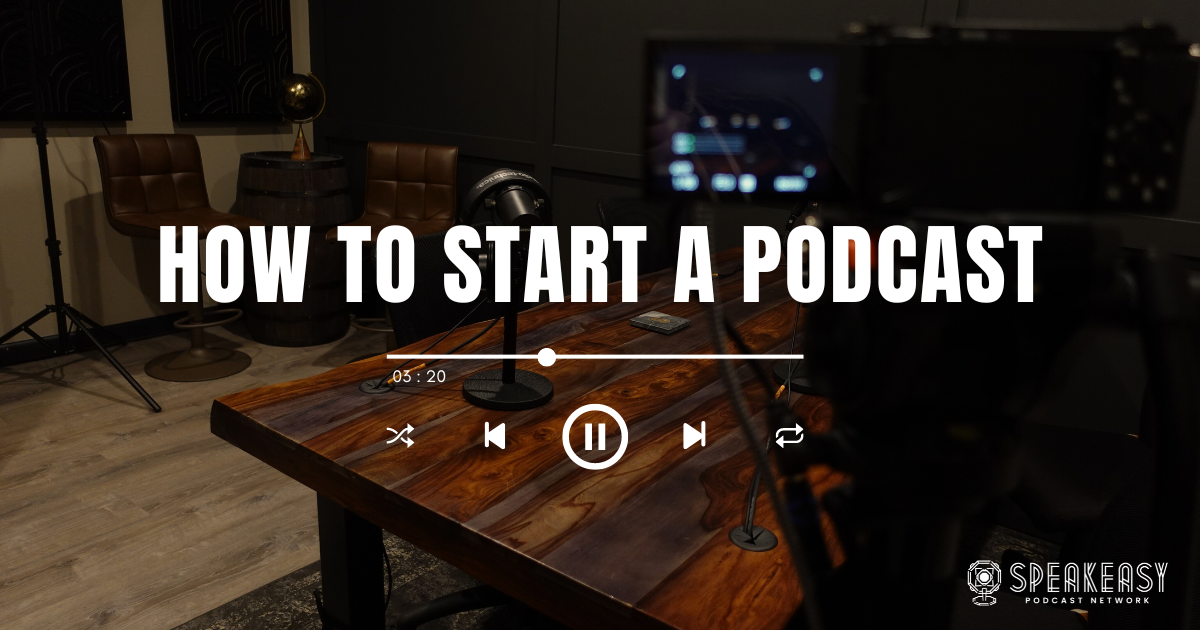7 steps to starting a successful podcast
In 2020, Podcasting surged to be one of the most popular mediums for shared ideas. In the years following, the creation of new shows dropped, but people's interest didn’t. Podcasts have become an increasingly popular medium for people to share their stories, interests, and expertise with the world. If you have been considering starting a podcast but don't know where to begin, you're in the right place! In this blog, we will cover the basics of how to start a podcast and provide actionable steps for you to follow.
Our background is in the production and consultation of podcasts for hobbyists and businesses. We’ve launched over 100 shows in our company’s four year history and we continue to develop new ways to help podcasters streamline the process, while gaining more attention for their show. Let’s get started!
Step 1: Choose Your Podcast Topic
The first step in starting a podcast is choosing your topic. Think about your interests, skills, and passions. What do you want to talk about, and what do you want your audience to learn or gain from listening to your podcast? It's important to choose a topic that you are passionate about because creating a successful podcast requires a lot of time and effort. You want to make sure you enjoy the process and are motivated to keep going.
Step 2: Choose Your Podcast Format
The next step is to choose your podcast format. There are several different formats to choose from, including:
Interview: You invite guests to share their knowledge, experiences, and stories with your audience.
Solo: You host the podcast by yourself and share your own insights and stories.
Co-hosted: You and a partner share hosting duties and discuss a particular topic or theme.
It's important to choose a format that aligns with your topic and goals. If you want to share your expertise with others, a solo format may be best. If you want to interview experts in your field or discuss current events, an interview or co-hosted format may be better suited.
Step 3: Choose Your Podcast Name and Branding
Your podcast name and branding are crucial components of your podcast's success. Your name should be easy to remember, catchy, and related to your topic. Your branding should also be consistent and visually appealing.
Once you have chosen your podcast name and branding, it's important to secure your domain name and social media handles. This will help you establish your brand and make it easier for your audience to find you.
If you need help with this, Speakeasy Podcast Network helps, ensuring that your branding, naming, and audience identification is on point!
Step 4: Choose Your Podcast Equipment
Before you start recording your podcast, you will need to invest in some equipment. The good news is that you don't need to spend a lot of money to get started. Here are the essential items you will need:
Microphone: A good quality microphone is essential for producing high-quality audio. You can find a decent microphone for under $100.
Headphones: Headphones are important for monitoring your audio levels and making sure your audio sounds clear and crisp.
Recording Software: There are several free or low-cost recording software options available, such as Audacity, GarageBand, and Zencastr.
Step 5: Create a Podcast Outline
Before you start recording your podcast, it's important to create an outline. This will help you stay on track and ensure that your podcast is structured and engaging for your listeners.
Your outline should include:
Introduction: Introduce yourself and your podcast topic.
Topic Overview: Provide an overview of the topic you will be discussing.
Main Points: Outline the main points you want to cover in your podcast.
Conclusion: Summarize your main points and provide any final thoughts or takeaways for your listeners.
Step 6: Record Your Podcast
Now that you have your equipment and outline, it's time to start recording! Find a quiet room with minimal background noise and start recording.
Remember to speak clearly and at a consistent volume. It's also important to take breaks and rest your voice to avoid strain or fatigue.
Once you have finished recording, listen back to your audio and make any necessary edits. This is also a good time to add any intro or outro music to your podcast.
Step 7: Publish Your Podcast
Once you have finished editing your podcast, it's time to publish. Look at platforms like YouTube, Apple, Spotify, and iHeart radio to launch your podcast on. A great (free) option for a hosting platform is Anchor FM, which is now owned by Spotify.
We hope that helps you on your journey to your new podcast. Remember, the best piece of advice we can give you is that the most successful podcasts are ones that have a long-term plan. No one is Joe Rogan after 10 episodes!
Speakeasy Podcast Network is a division of Wayne Media Group and is headquartered in Brighton, Michigan. Speakeasy is the nation’s first creative studio that features podcast production as a core service. For more information, visit WayneMedia.com or SpeakeasyNetwork.com; one of the benefits of working with Wayne Media is that none of their services are outsourced as they operate 100% in-house. Happy podcasting!


